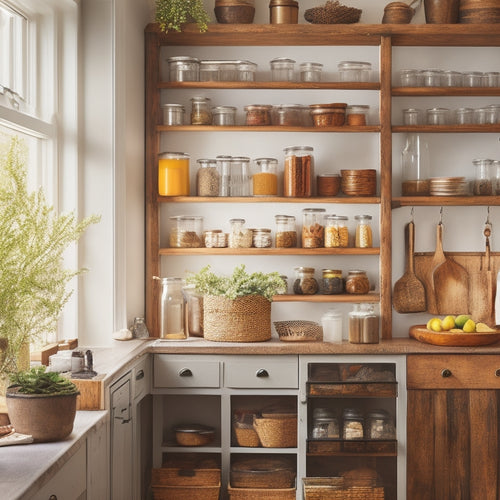
3 Essential Kitchen Drawer Templates for Easy Storage
Share
You're just a few templates away from transforming your kitchen drawers into a haven of organization and efficiency. Start with a customizable drawer organization plan, tailoring your layout to your specific needs and preferences. Next, maximize space by dividing your drawer into zones for specific items, like cooking utensils, baking supplies, and dinnerware. Finally, implement a utensil-specific storage system, using vertical dividers and designated zones to keep items organized and easily accessible. By incorporating these three essential kitchen drawer templates, you'll be well on your way to a more streamlined and stress-free kitchen experience – and there's even more to discover to take your organization to the next level.
Key Takeaways
• Create a zone-based system to categorize and store kitchen items, ensuring easy access and reducing clutter.
• Use dividers to separate utensils, cookware, and gadgets, keeping similar items together for efficient allocation.
• Implement utensil-specific storage solutions, such as vertical dividers and drawer inserts, to prevent tangling and damage.
• Designate areas for frequently used items, like sharp objects, to save time and reduce frustration.
• Label containers and sections clearly to facilitate quick identification and maintain a clutter-free kitchen drawer.
Customizable Drawer Organization Plans
You can create a kitchen drawer organization system tailored to your specific needs with customizable drawer organization plans. This approach allows you to optimize your storage space, making it easier to find what you need when you need it.
By designing a plan that suits your kitchen's unique layout and your personal preferences, you can make sure that every item has a designated place, reducing clutter and increasing safety.
To get started, consider using drawer dividers to separate items into categories, such as utensils, cookware, and gadgets. This will help you visualize your storage space and allocate it efficiently.
Additionally, label each container or section using clear and concise labels, making it easy to identify what's inside without having to rummage through the drawer.
With customizable plans, you can also accommodate special items, like sharp objects or heavy cookbooks, making certain they're stored safely and securely.
Maximizing Space With Zones
Divide your kitchen drawer into zones, each dedicated to a specific type of item or task, to reveal the full storage potential and maintain a clutter-free space. By creating separate areas for different items, you'll reduce clutter and make it easier to find what you need.
Use drawer dividers to separate zones and keep similar items together. For instance, designate a zone for cooking utensils, another for baking supplies, and another for dinnerware.
Compartmentalized layouts allow you to make the most of your drawer's space. Consider a zone for sharp objects, like knives and scissors, to keep them organized and out of reach of children. Another zone can be dedicated to spices, oils, or condiments, keeping them easily accessible.
By assigning a specific purpose to each zone, you'll make certain that your kitchen drawer remains organized and functional. This system also helps prevent overcrowding, reducing the risk of accidents and breakages.
With a zoned kitchen drawer, you'll enjoy a safer, more efficient cooking experience.
Streamlining Utensil Storage Systems
By implementing a utensil-specific storage system, your kitchen drawer can efficiently house even the most unwieldy items, from spatulas to whisks, keeping them organized and within easy reach. This means you'll no longer have to dig through a jumbled mess to find the right tool, saving you time and reducing frustration.
To create an effective utensil storage system, consider the following:
-
Use vertical dividers to separate utensils by type or size, keeping similar items together and making them easy to find.
-
Invest in drawer inserts specifically designed for utensils, which can help keep them organized and prevent them from getting tangled or damaged.
-
Designate a specific area of the drawer for frequently used items, such as a 'quick-grab' zone for your most-used utensils.
Frequently Asked Questions
How Do I Measure My Kitchen Drawers Accurately for Templates?
To measure your kitchen drawers accurately, you'll need to take precise dimensions, considering the drawer's width, height, and depth. Guarantee precision by using a ruler or tape measure, and don't forget to account for any obstructions or unusual shapes.
Can I Use These Templates for Other Storage Spaces, Like Closets?
You're wondering if you can repurpose these templates beyond kitchen drawers. The answer is yes! These versatile templates can be adapted for closet organization, providing space-saving solutions for your DIY organization projects.
Are the Templates Suitable for People With Disabilities or Arthritis?
When organizing spaces, you'll appreciate that these templates prioritize accessibility features and ergonomic design, ensuring adaptability and ease of use for individuals with disabilities or arthritis, allowing you to create safe and functional storage solutions.
Can I Customize the Templates to Fit My Personal Style or Decor?
Did you know that 77% of homeowners prioritize personalization when organizing their space? You can customize these templates to fit your style by exploring personalization options, enjoying design flexibility, and balancing practicality with versatility, ensuring a safe and functional kitchen.
Are the Templates Compatible With Non-Standard or Custom-Sized Drawers?
You can adapt the templates to fit non-standard or custom-sized drawers by creating custom drawer inserts, allowing you to design unique organization solutions that cater to your specific needs and guarantee a safe, clutter-free space.
Related Posts
-

Tips for Choosing Under-Cabinet Lighting Fixtures
When choosing under-cabinet lighting fixtures, consider your kitchen's layout and functionality. Assess countertop ma...
-

Creative Organization Ideas for Tight Kitchen Spaces
To create an organized kitchen in tight spaces, think upwards. Install shelves that reach the ceiling and use wall-mo...
-

Dish Drainer Options for Kitchen Islands
When selecting dish drainers for your kitchen island, consider options that maximize space and enhance workflow. Comp...


